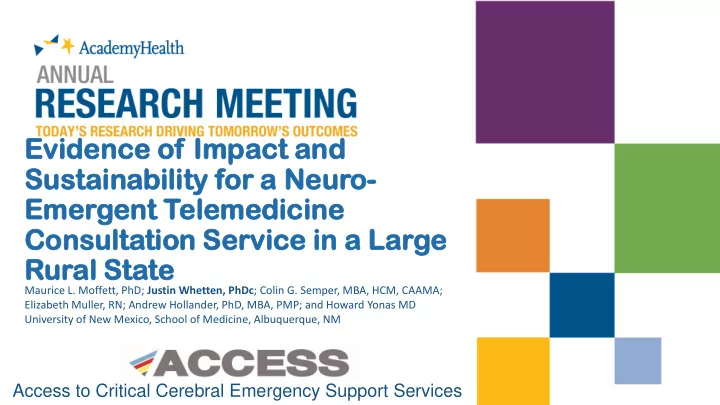

1 Ev Eviden ence ce of Impac act t an and Su Sust stai aina nabi bility lity for r a N a Neu euro- Em Emer ergen ent t Tel elem emed edicine icine Co Consulta ultation tion Se Service ce in a L a Lar arge e Rural al St State te Maurice L. Moffett, PhD; Justin Whetten, PhDc ; Colin G. Semper, MBA, HCM, CAAMA; Elizabeth Muller, RN; Andrew Hollander, PhD, MBA, PMP; and Howard Yonas MD University of New Mexico, School of Medicine, Albuquerque, NM Access to Critical Cerebral Emergency Support Services
DISCLAIMER 2 • The project described is supported by Grant Number 1C1CMS331351-01-00 from the Department of Health and Human Services, Centers for Medicare & Medicaid Services. The contents of this document are solely the responsibility of authors and do not necessarily represent the official views of the U.S. Department of Health and Human Services or any of it agencies. The research presented here was conducted by the awardee. Findings might or might not be consistent with or confirmed by the findings of the independent evaluation contractor.
Overview 3 • Designed to provide timely access to neuro-emergent care and prevent unnecessary transfer of patients who will arrive at rural emergency rooms for care. • Rural hospitals have difficulty maintaining availability of emergent consultations by neurologists and neurosurgeons. • ACCESS builds and expands existing partnerships in a comprehensive neurology and neuro-emergent telehealth network.
Providing Specialty Care in New Mexico 4 Counties and Population by Metropolitan, New Mexico is a large, Rural and Frontier Status rural state Frontier at < 6 per sq mile 2% probability of tPA in rural areas
Challenge or Opportunity 5 • The study pays for the consultations for CMS beneficiaries (Medicare, Medicaid), while hospitals must pay for patients who are commercially insured, self-pay or other insured through other payers. • Evidence for sustainability can be derived from the consultations in which rural hospitals reimburse the ACCESS program and the evaluation of types of consultations and disposition of patients.
Purpose of the study 6 • To evaluate the potential sustainability of the New Mexico ACCESS program after the initial funding is complete. • Outcomes • Payment source • Telemedicine consultations • Disposition from emergency department
Methods 7 • Population: Patients receiving telemedicine consultations for neuro-emergent encounters in ten (10) rural and frontier serving emergency departments in New Mexico. • Data: • Consultation data (REDCap) • Discharge abstract (Spoke Hospital) • State Inpatient Data (HCUP)
Methods 8 • Timeframe: May 2015 – February 2017 • Setting: Rural emergency departments • Subjects: Patients admitted to rural emergency departments • Reimbursement for non-CMS: • $600 Neurology • $1,200 Neurosurgery
Consultations by 9 Primary Payer Self pay Other Commercial 2% 3% Insurance 17% Presumptively eligible for Medicaid Medicare 4% 52% Medicaid 22% N = 1,326
Consult Types by 10 Primary Insurance Consult Type Primary Insurance Neurology Neurosurgery Medicare 636 59 Medicaid 274 16 Presumptively Eligible 56 2 Sub-total 966 77 $672,000 Commercial Insurance 205 17 Self pay 25 1 Other Payer 31 4 Sub-total 261 22 $183,000 Total 1,227 99 $855,000
Effects on Reimbursement 11 • Total Charges Inpatient Admission • All MDC 01 = 9,233 – Average Charges = $33,083 (95% CI: $31,830 - $34,337) • Non-Surgical MDC 01 = 7,988 – Average Charges = $24,885 (95% CI: $23,788 - $25,982) • Expected Local Charges • Prior data: 15% local retention rate
Effects on Reimbursement: All Hospitals 12 • All Hospitals Admitted to Local Primary Insurance Hospital Discharged Transferred Other Medicare 463 132 71 29 Medicaid 140 99 37 14 Presumptively Eligible 29 12 12 5 Sub-total 632 243 120 48 Commercial Insurance 105 79 27 11 Self pay 8 11 5 2 Other Payer 16 10 6 3 Sub-Total 129 100 38 16 Total 761 200 76 32 85% of Total 647 Expected Total Charges $18,937,485 Expected Increase $16,100,595
Effects on Reimbursement: Largest Hospital 13 Admitted to Local Transferred to Primary Payer Discharged Other Hospital Other Hospital Medicare 330 51 18 17 Medicaid 86 53 10 7 Presumptively Eligible 21 7 7 4 Commercial Insurance 61 24 10 9 Self pay 6 3 2 1 Other Payer 0 1 0 1 Total Encounters 504 139 47 39 85% of Total 428 Neurology 678 Expected Total Charges $12,542,040 Neurosurgery 51 Expected Increase $10,650,780
Effects on Reimbursement: Smallest Hospital 14 Admitted to Local Transferred to Other Primary Insurance Discharged Other Hospital Hospital Medicare 1 0 6 0 Medicaid 0 1 0 0 Commercial 0 0 1 0 Insurance Self pay 0 0 2 0 Other Payer 0 0 1 0 Total 1 1 10 0 Expected Total $24,885 Charges Neurology 12
Conclusions 15 • Works to keep care local • 85% / 15% 15% / 85% • Self Sustaining • $855K $16.1M • Works better for larger hospitals
Impact: Scalability & Replicability 16 • Neuro-emergent care • Rest of the hospitals in NM • Other states • Other emergent conditions
DISCLAIMER 17 • The project described is supported by Grant Number 1C1CMS331351-01-00 from the Department of Health and Human Services, Centers for Medicare & Medicaid Services. The contents of this document are solely the responsibility of authors and do not necessarily represent the official views of the U.S. Department of Health and Human Services or any of it agencies. The research presented here was conducted by the awardee. Findings might or might not be consistent with or confirmed by the findings of the independent evaluation contractor.
Recommend
More recommend